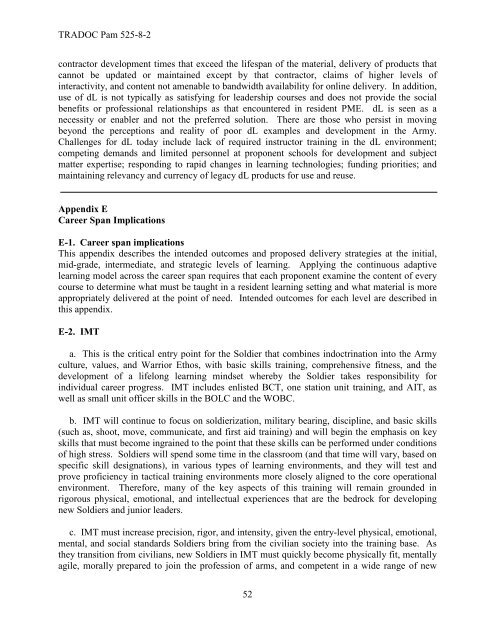K3zgZ
K3zgZ
K3zgZ
Create successful ePaper yourself
Turn your PDF publications into a flip-book with our unique Google optimized e-Paper software.
TRADOC Pam 525-8-2<br />
contractor development times that exceed the lifespan of the material, delivery of products that<br />
cannot be updated or maintained except by that contractor, claims of higher levels of<br />
interactivity, and content not amenable to bandwidth availability for online delivery. In addition,<br />
use of dL is not typically as satisfying for leadership courses and does not provide the social<br />
benefits or professional relationships as that encountered in resident PME. dL is seen as a<br />
necessity or enabler and not the preferred solution. There are those who persist in moving<br />
beyond the perceptions and reality of poor dL examples and development in the Army.<br />
Challenges for dL today include lack of required instructor training in the dL environment;<br />
competing demands and limited personnel at proponent schools for development and subject<br />
matter expertise; responding to rapid changes in learning technologies; funding priorities; and<br />
maintaining relevancy and currency of legacy dL products for use and reuse.<br />
Appendix E<br />
Career Span Implications<br />
E-1. Career span implications<br />
This appendix describes the intended outcomes and proposed delivery strategies at the initial,<br />
mid-grade, intermediate, and strategic levels of learning. Applying the continuous adaptive<br />
learning model across the career span requires that each proponent examine the content of every<br />
course to determine what must be taught in a resident learning setting and what material is more<br />
appropriately delivered at the point of need. Intended outcomes for each level are described in<br />
this appendix.<br />
E-2. IMT<br />
a. This is the critical entry point for the Soldier that combines indoctrination into the Army<br />
culture, values, and Warrior Ethos, with basic skills training, comprehensive fitness, and the<br />
development of a lifelong learning mindset whereby the Soldier takes responsibility for<br />
individual career progress. IMT includes enlisted BCT, one station unit training, and AIT, as<br />
well as small unit officer skills in the BOLC and the WOBC.<br />
b. IMT will continue to focus on soldierization, military bearing, discipline, and basic skills<br />
(such as, shoot, move, communicate, and first aid training) and will begin the emphasis on key<br />
skills that must become ingrained to the point that these skills can be performed under conditions<br />
of high stress. Soldiers will spend some time in the classroom (and that time will vary, based on<br />
specific skill designations), in various types of learning environments, and they will test and<br />
prove proficiency in tactical training environments more closely aligned to the core operational<br />
environment. Therefore, many of the key aspects of this training will remain grounded in<br />
rigorous physical, emotional, and intellectual experiences that are the bedrock for developing<br />
new Soldiers and junior leaders.<br />
c. IMT must increase precision, rigor, and intensity, given the entry-level physical, emotional,<br />
mental, and social standards Soldiers bring from the civilian society into the training base. As<br />
they transition from civilians, new Soldiers in IMT must quickly become physically fit, mentally<br />
agile, morally prepared to join the profession of arms, and competent in a wide range of new<br />
52




